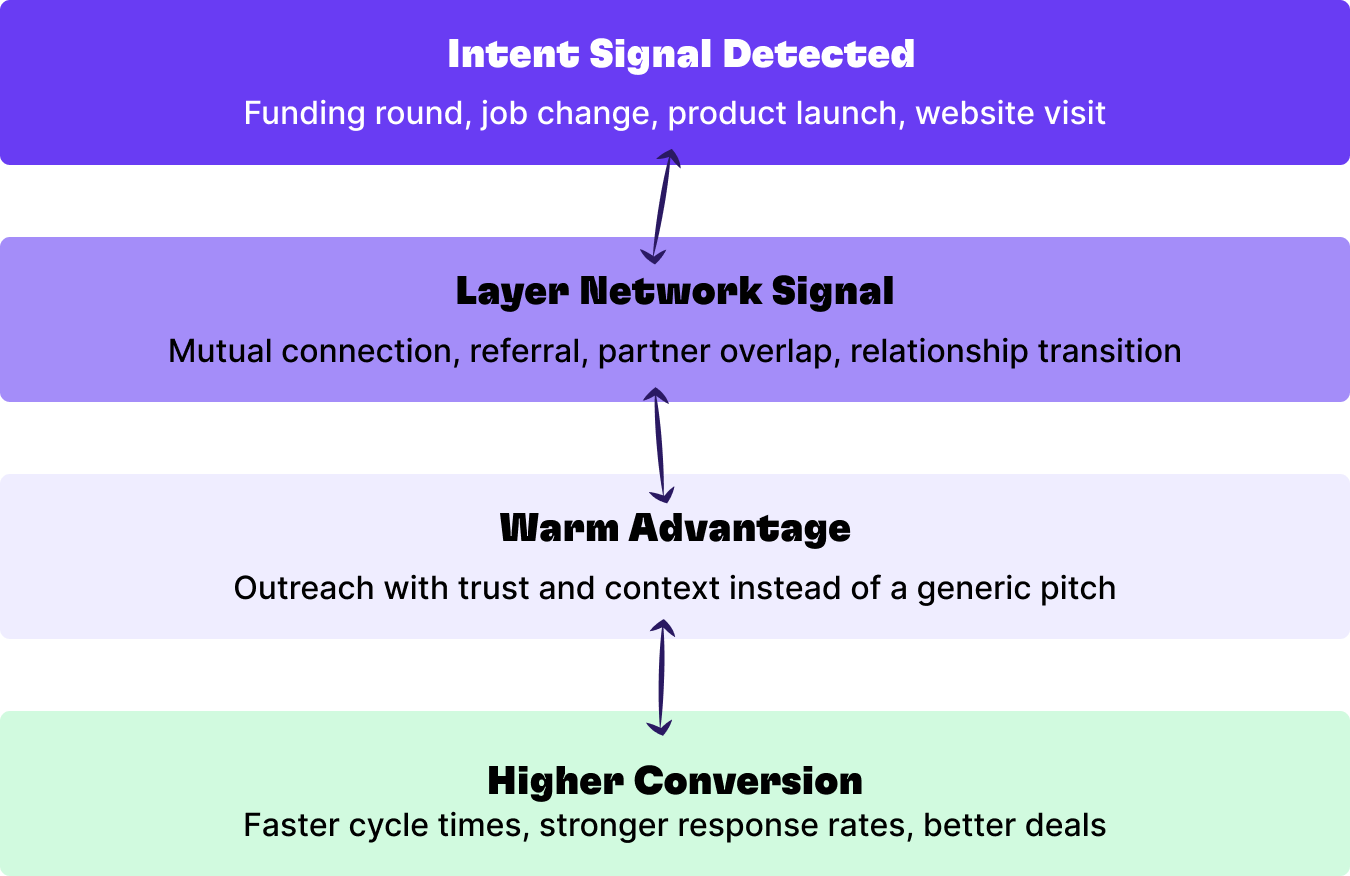Referred B2B accounts are 4× more likely to buy and tend to have 16 % higher lifetime value than non-referred accounts. [1]
Think of dinosaurs. Paleontologists believe sauropods like the Brontosaurus used deep, low-frequency rumbles that could travel for miles. Those weren’t random noises, they were signals only their herd could detect and act on.
That’s what network signals are in sales: the human-layer signals only you can pick up on because of who you know and the trust you carry.

Most sales teams are trained to chase market signals: funding rounds, leadership hires, product launches, big press announcements. These data points are interesting, but they’re noisy. Every seller in your market can see them, and every prospect gets flooded with the same “Congrats on your Series B!” email within hours.
Network signals are different.
They live in the relationship layer of selling — the messy, human part that isn’t obvious from a press release or LinkedIn update. A network signal says not just “something happened” but “you have a real way in here.”In today’s sales landscape, buyers are overwhelmed. Inboxes are flooded, cold calls ignored, ads skipped. Trust is the scarce resource.That’s why network signals change the game: they build trust into the very first touch.
What Are Network Signals?
Market signals tell you something interesting has happened.Network signals tell you something happened and you can act on it through people you already know.The key distinction is the relationship layer. It’s not just ambiguous data, it’s a signal with human context. It’s real leverage you can use to get in the door or your target accounts.

The Importance of Network Signals
Market signals tell you where the action is. Network signals tell you where the action is for you.When you sell through them:
- Response rates jump because trust comes first.
- Sales cycles shorten because doors open faster.
- Conversations feel human, not scripted.
Instead of “ugh, another cold pitch,” you get: “oh, a note from a friend of a friend.”
When you sell through network signals, you stop sounding like everyone else and start sounding like someone worth listening to.Here’s what happens when you lean into them:
- Response rates jump. LinkedIn data shows buyers are 7x more likely to respond to outreach from a trusted introduction.
- Sales cycles shrink. Deals that start with a referral or warm path move faster, sometimes twice as fast, because you’re skipping months of trust-building.
- Conversations feel human. Instead of opening with a generic pitch, you open with credibility: “I was speaking with [mutual contact] and they suggested we connect.”
The bottom line is that market signals show you where something’s happening. Network signals show you where you have an advantage.
In a world where pipeline is harder and harder to fill with cold outbound, your network isn’t just a safety net. It’s your most valuable pipeline.

Types of Network Signals
Connection Signals
Someone in your network shares a connection with a prospect creating natural introduction opportunities.
For example: The CFO at your target account went to school with your current customer’s VP. Suddenly, that cold email doesn’t feel so cold.
Hiring Signals
When people you know, (customers, partners, former colleagues, etc) change roles and land in positions where they could become internal champions.
For example: Your former customer who loved your product just became VP of Sales at a high-value target account.
Partnership Signals
Partners, integrators, or vendors create opportunities for warm introductions or co-selling situations.
For example: An integration partner mentions they're implementing at a company that fits your ideal customer profile.
Referral Signals
Happy customers or advocates can open doors to people you’ve never met or even know about. When trust is already established, introductions to extended networks become easy.
For example: A happy customer introduces you to a former colleague now leading sales ops at a target account, instantly opening a door you couldn’t reach with cold outreach.
How to Activate Network Signals
Spotting a network signal is only valuable if you actually do something with it. The key is to move quickly, respectfully, and with clarity. Here are the core actions to turn signals into pipeline:
1. Ask for the Intro
Reach out to your shared contact with a clear, low-effort ask:
“Would you feel comfortable introducing me to [Name]?”
Keep it specific. One person, one company. And give them a short, easy-to-copy blurb to make it frictionless.
2. Anchor in Context
When you connect, reference why the intro makes sense.
“I saw you and [mutual contact] worked together at Acme, they thought it’d be worth us connecting.”
This instantly shifts your message from a cold pitch to a credibility-backed conversation.
3. Time It Right
Signals are time-sensitive. Whether it’s a new role, funding round, or partnership, timing is everything.
Move quickly, ideally within days of spotting the signal, so your outreach feels relevant, not random.
4. Make It Easy to Say Yes
Respect the relationship. Give people a soft entry point:
“Happy to share a quick resource or hop on a 15-min call.”
Small, specific asks make it easier for both your connector and your prospect to say yes.
5. Reciprocate and Close the Loop
Thank the person who helped, publicly or privately. Share how the intro went so they know their effort paid off.
Look for ways to return the favor: make an intro for them, pass along intel, or highlight their work.
That’s how you turn one signal into lasting influence.
Activating network signals isn’t about blasting outreach. It’s about using context, trust, and timing to turn hidden pathways into open doors. When you consistently ask, anchor, time, simplify, and reciprocate, your network becomes a living pipeline.
Layering Network Signals with Intent Signals
Intent signals are everywhere. A company raises a Series B. A VP of Sales updates their LinkedIn. A product launch makes the news. These are all useful data points, they tell you where something interesting is happening.
But here’s the problem: everyone sees them. Every seller in your space is firing off the same “Congrats on the funding!” email or sending the same InMail about the new hire. By themselves, market signals often turn into noise.
This is where network signals change the game.When you layer network signals on top of intent signals, you move from generic outreach to personalized advantage:

Funding Round + Mutual Connection
Everyone sees the raise. But you notice your customer’s CFO went to school with their new VP of Finance. Instead of cold congratulations, you get a warm introduction into their buying team.
Leadership Change + Relationship Transition
A new CRO joins your dream account. Dozens of sellers pile in. But you recognize them as a former champion from your last company. Now you have a reason to reach out with credibility and history.
Hiring Spree + Partner Ecosystem
A target account is staffing up in engineering. Every competitor is sending emails. You discover your integration partner is already onboarding with their IT team, giving you a ready-made warm pathway in.
Market signals tell you where the door is. Network signals hand you the key.
By layering the two, you avoid the noise of “me too” outreach and create conversations rooted in trust, timing, and context.
14 Questions You Need to Ask When You See A Network Signal
- “How well do you know [Prospect’s Name]? Would you be comfortable making a warm intro?”
- “What’s your impression of [Prospect/Company]? Any context I should know before reaching out?”
- “Congrats on the new role! What are your top priorities in the first 90 days?”
- "At [previous company], you mentioned X was a challenge. Do you expect something similar here?"
- "What conversations are you already having with [Target Company] that we might align with?"
- "Would it be helpful if we teamed up on a joint solution pitch for [specific initiative or pain point]?"
- "What's the best way to position our solution so it resonates with your leadership team?"
- "Who else should I involve early to make sure this gets traction internally?"
- “What’s the best timing for me to reach out so it feels natural, not forced?”
- “Is there a specific project, budget cycle, or initiative coming up I should align with?”
- “What language or framing would resonate most with this team/leader?”
- “Do you think they’d respond better to an email intro, LinkedIn message, or a call?”
- “If you were in my shoes, how would you approach them?”
- “What’s one piece of context I should know to avoid coming across as just another vendor?”
Your pipeline is cold. Heat it up with network signals.
Ready to go beyond basics and get warm intros in a scalable and trackable way?
Commsor makes it easy to tap into your company’s network of employees, partners, investors, advisors and more to find warm paths to prospects, key stakeholders and decision makers.
You bring your network, Commsor will help you create warmer revenue.
Learn more at Commsor.com.








